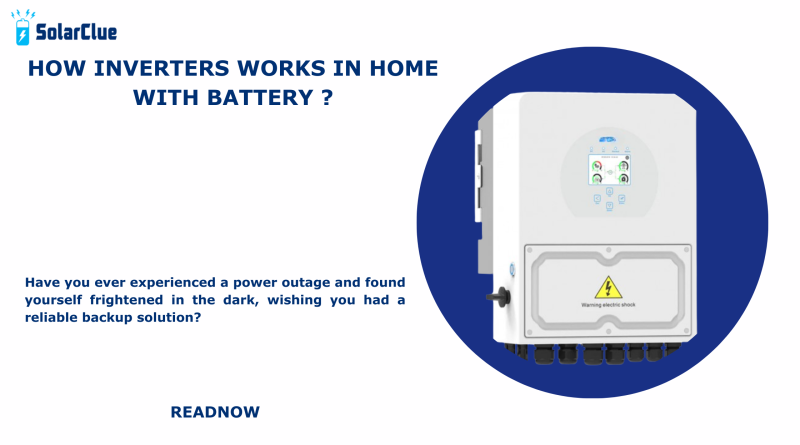How inverters works in home with Battery ?
Have you ever experienced a power outage and found yourself frightened in the dark, wishing you had a reliable backup solution? Well, fear not, because inverters and batteries have got you covered! In today’s world, where energy independence and resilience are becoming increasingly important, having a home energy storage system with an inverter is like having a superhero on standby.
Table of Contents
About Inverter & How does it work ?
Essentially, an inverter is a device that converts direct current (DC) electricity into alternating current (AC) electricity. This conversion is crucial because most household appliances and electronics run on AC power.
In a typical solar energy system, the solar panels generate DC electricity from the sun’s rays. This DC electricity then needs to be converted into AC electricity that can be used to power your home or fed back into the grid. That’s where the inverter comes into play.
The inverter takes the DC electricity from the solar panels (or batteries) and performs some electrical magic to convert it into AC electricity that matches the voltage and frequency required by your home’s electrical system. It’s like a translator, helping your solar energy system and your home’s electrical system speak the same language.
The Magic of Batteries and Inverters :
Now, let’s add batteries to the mix. Batteries are like energy storage tanks, allowing you to capture and store excess electricity generated by your solar panels for later use. When the sun isn’t shining, or during a power outage, the batteries can provide the stored energy to keep your home running smoothly.
But here’s where the inverter becomes even more Important. Without an inverter, the DC electricity stored in the batteries would be useless for powering your AC appliances and electronics. That’s where the inverter steps in, converting the DC electricity from the batteries into AC electricity that your home can understand and utilize.
Types of Inverters for Home Battery Systems :
All inverters are not created equal. When it comes to home battery systems, there are two main types of inverters to consider:
1.Off-Grid Inverters: Off grid inverters are designed for homes that are completely disconnected from the utility grid. They are typically larger and more robust, capable of handling higher loads and providing backup power for extended periods.
2.Grid-Tied Inverters: On-grid inverter/Grid-Tied inverters are designed to work in side by side with the utility grid. During a power outage, they can seamlessly switch to using the energy stored in the batteries, providing backup power to keep your essential appliances and electronics running.
Inverter Efficiency and Battery Management
One important aspect to consider when choosing an inverter for your home battery system is efficiency. Inverters with higher efficiency ratings ensure that less energy is lost during the conversion process, maximizing the use of your stored battery power.
Additionally, many modern inverters come with advanced battery management systems. These systems monitor and regulate the charging and discharging of your batteries, ensuring optimal performance and longevity. They can also provide valuable data and insights into your energy usage patterns, helping you make informed decisions about your energy consumption.
Sizing Your Inverter and Battery System
Choosing the right size inverter and battery system for your home is crucial. An undersized system may not meet your energy needs, while an oversized system can be unnecessarily expensive and wasteful.
To determine the right size, you’ll need to consider factors such as your energy consumption patterns, the number of appliances and electronics you want to power during an outage, and the desired backup duration. Working with a professional solar installer can help you accurately assess your needs and recommend the appropriate inverter and battery system for your home.
Conclusion:
In the ever-evolving world of energy solutions, inverters and batteries have become indispensable components for homeowners seeking energy independence and resilience. By understanding how these two technologies work together, you can harness the power of the sun, store excess energy, and keep your home running smoothly, even during power outages.
Whether you’re looking to go off-grid or simply want a reliable backup system, investing in an inverter and battery solution can provide peace of mind and a sustainable path forward. So, embrace the magic of inverters and batteries, and enjoy the freedom of energy self-sufficiency in your home.
Visit SolarClue® to see the best Solar Inverters. SolarClue® actively sells solar energy products at discounts of up to 50% on its online marketplace.
Frequently Asked Questions
1.How do inverters convert DC to AC?
Inverters convert DC to AC by rapidly switching the DC input on and off to create an alternating current. This switched current passes through a transformer to produce a smooth AC output. Filters and additional circuitry then refine this output into a clean sine wave suitable for use.
2.What is inside an inverter?
An inverter consists of three elements: a converter circuit that converts AC current into DC current, a capacitor, and a power inverter circuit.
3.Why are inverters used?
An inverter is a device which helps in converting the direct current electricity into alternate current electricity. People mainly use inverters as a power source to run devices during power cuts.
4.What is the best use of inverter?
The best use of Inverter is in electric lights, kitchen appliances, microwaves, power tools, TVs, radios, computers.
5.What is the main function of an inverter?
The function of an inverter is to convert Direct Current (DC) into Alternating Current (AC). Batteries or solar panels produce DC current.


